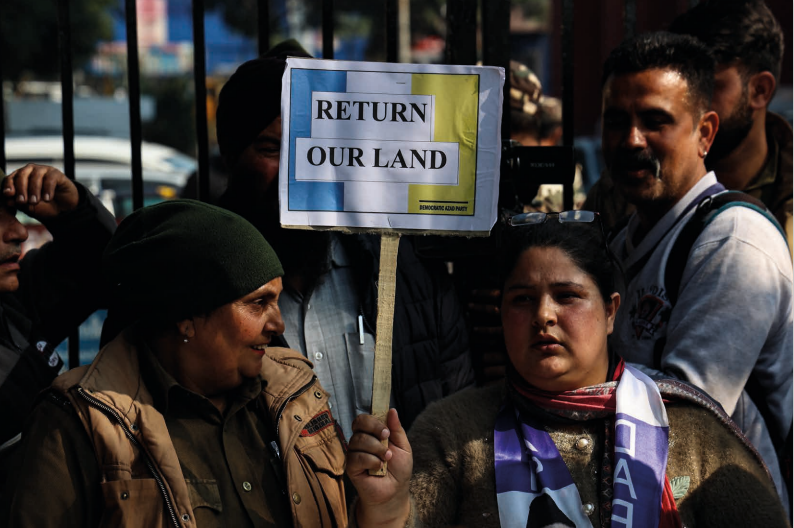Kashmir: Demolitions, Land Dispossession and Degradation

A day after a 22 April 2025 attack that killed 26 civilians and wounded at least 20 at a popular tourism local at Baisaran, in South Kashmir, local Kashmiris mounted shutdowns and massive protests from nearby Pahalgam to Srinagar, and from Kishtwar to Doda in Jammu. That marked the first time in three decades that militant killings had triggered outrage with such unity and at such a scale.
The Resistance Front (TRF), an offshoot of the Pakistan-based UN-designated terrorist group Lashkar-e-Taiba, initially claimed responsibility. The group stated that the attack was an act of resistance against the Indian government’s 2019 revocation of Kashmir’s autonomy, allowing Indian citizens to live and work in Kashmir, and transferring non-local settlers and land grabbers into the region. Four days later, the group retracted their claim.
India blamed Pakistan for sponsoring the Pahalgam attack. Pakistan’s government has fiercely rejected the charge. Both militaries mobilized and fired across the Line of Control, and Pakistan suspended the Simla Agreement, which then restricted trade, and closed the airspace, and demanded a ‘neutral’ investigation.
India also applied the “Israeli tactic” of collective punishment by blowing up nine homes of suspects in the attack and their families, often damaging neighboring homes and other structures. Other collective punishment saw India revoking the visas of Pakistanis in India. Reports have emerged from at least seven Indian cities of right-wing Hindu nationalists harassing and attacking Kashmiri civilians.
These developments follow a previously reported pattern formed last year, whereby Indian authorities continued to expropriate property throughout 2024.
Throughout the period since Land Times’ most-recent update on Kashmir land issues, Indian authorities continued to commit gross human rights violations in Indian-occupied Kashmir (IAK).
On 5 November 2024, Indian authorities reiterated their policy of razing the home of anyone they deemed to have “sheltered” a person they label a “terrorist.” On 13 November 2024, India’s National Investigation Agency (NIA) expropriated property belonging to the father of man from Zaldagar, Srinagar, accused to have been involved in the killing of two non-locals in February 2024. On 24 November 2024, a Rajouri district court legalized the expropriation of property of 14 Kashmiris, including a married couple, believed to have illegally crossed the Line of Control into Pakistan-occupied Kashmir (PoK) in 2011.
On 26 November 2024, FORUM-ASIA condemned land grabbing in the name of Indian railway expansion in IAK, dispossessing Kashmir apple farmers. This followed three weeks after publication of an important study of the protracted crisis of Indigenous food sovereignty amid de-development in Kashmir. Its message and timeliness are appropriate as we commemorate the 10th anniversary of the Committee on World Food Security adopting the global Framework for Action to ensure food security and nutrition through protracted crises.
Land Degradation
Riverbed mining continued to provide another context for Kashmiri land deprivation. Riverbed mining in Kashmir`s rivers has severely damaged the environmental in IAK. This particularly true in the Jhelum, where changes in river morphology has led to extensive damage to homes, farmlands, orchards and riverbanks, severe pollution, flash floods, water scarcity and, consequently, increased food security in IAK.
However, plenty of local factors have degraded lands across Kashmir. Researchers recently have sounded the alarm about such land-degradation practices linked to deforestation, water pollution, solid waste disposal, industrialization, lack of awareness and environmental education have led to environmental degradation, loss of biodiversity and shrinking water bodies.
Moreover, some 1,200 glaciers in the region have been melting at a rate of 35cm in thickness annually from 2000 to 2012. As seen in the serial mega floods of 2010 and 2022, the degradation of the global environment is likely to bring greater flooding and erosion of Kashmir’s lands.
The Human Rights Dimension
The trend shows increasing violations of Kashmiris human right to land arising not only from a physiological need and land as a subject of the human right to a safe, clean and sustainable environment, but also as essential to self-determination, however that may be defined as internal or external to an independent state and its territory of effective control. Primarily, these violations have accelerated predictably following legal changes implemented in Jammu & Kashmir since the Indian Parliament revoked the territory’s special autonomous status in August 2019, with the Indian Supreme Court’s later endorsement.
By October 2020, the majority of Jammu & Kashmir’s progressive land laws had been either amended or repealed, resulting in evictions, destruction of property, and land confiscation that affected thousands of Kashmiris in violation of international human rights laws and standards.
The International Federation for Human Rights (FIDH) has concluded that “The Indian government’s obliteration of Jammu & Kashmir’s legal framework, which had protected land rights for decades, has already had a disastrous impact on the Kashmiri people. Thousands have already been evicted from their lands and lost their homes. Key European Union and United Nations institutions, including the UN Human Rights Council, must wake up to this human rights crisis and start putting public pressure on the Indian government to adhere to its own international legal obligations.”
As noted in the recent examples above, the increased repression of Kashmir’s civic space, criminalization of its civil society and alien domination of its lands have converged to re-create a colonial model in Kashmir that mirrors other situations of colonial rule and irredentism.
Photo: Cover photo from FIDH’s recent publication on Kashmir land rights, showing activists protest against a government circular ordering the removal of so-called encroachment on state land in Jammu City, 16 January 2023. Source: Nasir Kachroo/NurPhoto via AF.
* 1 kanal = 505.86 square meters. This unit of measure is used for land area calculation in Jammu and Kashmir, Haryana, Punjab, and Himachal Prades
|